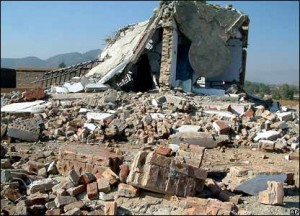'Invisibility cloak' could protect buildings against earthquakes

Researchers at the University of Liverpool have shown that it's possible to develop an 'invisibility cloak' to protect buildings from surface waves that are generated during earthquakes. These types of seismic waves travel across the earth's surface causing much of the destruction which follows earthquakes, unlike body waves which travel through the earth and are less destructive.
The cloaking technology involves the use of concentric rings of plastic which could be fitted to the Earth's surface to divert surface waves. For buildings, that means installing the rings into foundations. The researchers say that by controlling the stiffness and elasticity of the rings, waves traveling through the 'cloak' pass smoothly into the material and are compressed into small fluctuations in pressure and density. They add that the path of the surface waves can be made into an arc that directs the waves outside the protective cloak.
"We are able to 'tune' the cloak to the differing frequencies of incoming waves which means we can divert waves of a variety of frequencies. For each small frequency range, there is a pair of rings which does most of the work and these move about a lot – bending up and down – when they are hit by a wave at their frequency," said Sebastien Guenneau, from the University's Department of Mathematics, who developed the technology with Stefan Enoch and Mohamed Farhat from the Fresnel Institute (CNRS) in Marseilles, France.
However, the technology cannot dissipate any of the massive energy from waves, which could potentially be an issue for clusters of buildings in city centers. The researchers explain: "The waves are then directed outside the cloak where they return to their previous size. The cloak does not reflect waves – they continue to travel behind it with the same intensity. At this stage, therefore, we can only transfer the risk from one area to another, rather than eliminate it completely."
The team says that their work has "enormous potential" for offering protection in densely populated areas around the world that are at risk from earthquakes. Their challenge is to turn their theories into real applications, and small scale experiments are underway. For instance, they've designed an 'elastic' cloak to protect against body waves, and the team is currently seeking a suitable material to accommodate the elastic parameters of the cloak.
There is no rough timetable for when the technology could be put into building production and no information if it would be available for seismic retrofitting or limited to new development. In any case, the innovation looks promising.
